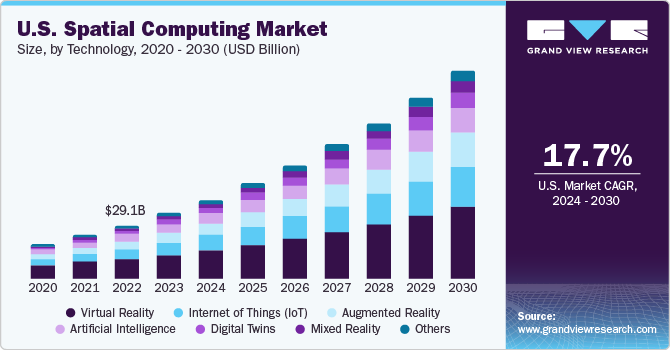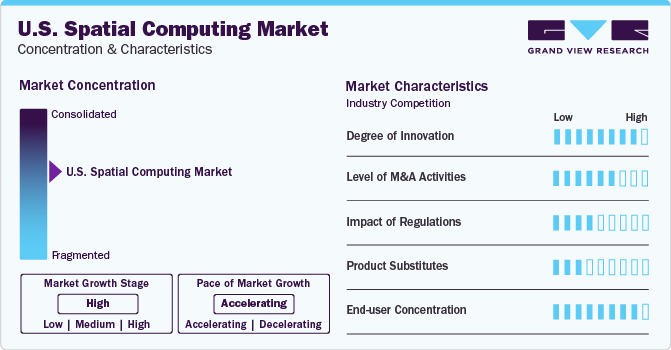
U.S. Spatial Computing Market Size, Share & Trends Analysis Report By Solution (Hardware Devices, Software, Services), By Technology, By End-Use, And Segment Forecasts, 2024 - 2030
- Report ID: GVR-4-68040-248-8
- Number of Report Pages: 120
- Format: PDF
- Historical Range: 2018 - 2023
- Forecast Period: 2024 - 2030
- Industry: Technology
U.S. Spatial Computing Market Size & Trends
The U.S. spatial computing market size was valued at USD 35.9 billion in 2023 and is expected to grow at a CAGR of 17.7% from 2024 to 2030. The increasing demand for immersive experiences, remote collaboration, and better user experiences is prompting the adoption of spatial computing technology across various industries. Spatial computing has applications in various industries, such as gaming & entertainment, healthcare, education, etc. These industries are leveraging spatial computing to enhance customer experiences, improve training and simulation, streamline design and prototyping processes, enable remote collaboration, and unlock new business opportunities.

In 2023, the U.S. accounted for over 25.0% of the spatial computing market. Spatial computing blends data from the world around them in a natural way. It enables users to engage with digital content more naturally and intuitively by seamlessly blending the digital and physical realms, enhancing human-computer interaction and creating immersive experiences. It helps users explore virtual worlds, interact with virtual objects, or visualize data in 3D space by providing a level of immersion which is not possible in traditional computing interfaces.
Spatial computing brings AR, VR, and MR technologies together which enables seamless transitions between virtual and real-world elements, creating a spectrum of experiences and expanding the possibilities for advanced computing applications. Moreover, the integration of AI and IoT technologies is helping in the creation of more intelligent and improved user experiences in the market.
With the integration of AI algorithms in spatial computing, real-time object recognition, scene understanding, and personalized interactions have become possible. IoT connectivity enables computing devices to interact with the physical environment and other connected devices, creating a seamless and interconnected ecosystem. For instance, gaming and entertainment industry has transformed gaming experiences by enabling the players to immerse themselves in virtual worlds and interact with virtual objects.
Market Concentration & Characteristics
The market is characterized by a high degree of innovation as spatial computing is an evolving technology. For instance, in June 2023, Apple Inc. launched Vision Pro, a spatial computing device that uses the M2 and R2 chipset for streaming images to the display within 12 milliseconds for a virtual, lag-free, real-time view of the world. Its unique dual‑chip design enables spatial experiences on Vision Pro. The powerful M2 chip simultaneously runs visionOS, executes advanced computer vision algorithms, and delivers stunning graphics, all with incredible efficiency.

Instances of mergers and acquisitions are also frequent in the market. In May 2022, Google announced the acquisition of California-based startup Raxium, an innovator in single panel MicroLED display technologies. The acquisition is expected to help Google build next generation of AR/VR headsets.
Impact of regulations is also high in the market as concerns about data privacy and security play a significant role in spatial computing. Spatial computing devices collect and process users’ data as well as third-party data. This becomes particularly important in industries such as healthcare and finance, where data privacy and security are of the utmost importance.
End-use concentration is also high in the market as sectors such as healthcare, education, aerospace and defense, automotive, gaming, consumer electronics, government and public sector, information and technology, energy and utilities, etc. are integrating the spatial computing technology to improve workflows, enhance visualization, and enable remote collaboration.
Solution Insights
Based on solutions, the hardware devices segment dominated the market with the largest revenue share of over 65.0% in 2023. Head-mounted displays such as virtual reality headsets and augmented reality glasses provide users with immersive visual experiences by overlaying digital content in the real world or creating an entirely virtual environment. Wearable devices such as smartwatches, fitness trackers, and clothing embedded with sensors can contribute to the spatial computing ecosystem.
The services segment is expected to grow with the highest CAGR over the forecast period. The services component allows for more efficient and cost-effective maintenance of spatial computing systems, as well as faster response times when issues arise. For instance, healthcare providers may require different spatial computing solutions than retailers or manufacturers. This has led to a growing number of specialized service providers in the market.
Technology Insights
Based on technology, the VR segment dominated the market with the largest revenue share in 2023. Spatial computing involves the integration of VR to create an immersive and interactive experience for users. The use of VR technology in spatial computing allows for more realistic and engaging experiences, with applications ranging from gaming & entertainment to education, healthcare, and training, among others. The growth of the segment is further expected to be fueled by advancements in AI, which enable more personalized and intuitive experiences for users.
The MR segment is expected to grow with the highest CAGR over the forecast period. The segment combines AR and VR to create immersive and interactive experiences by overlaying visual objects onto the real world in a realistic and interactive way that seamlessly blend virtual content with the real world. This creates a sense of presence and allows users to interact with virtual content more naturally and intuitively.
End-use Insights
The gaming industry dominated the market with the largest revenue share in 2023 as spatial computing creates immersive and entertaining experiences that allow users to interact with virtual objects and characters. Players can use hand gestures or eye-control with this technology rather than using keyboards or joysticks. In June 2023, Apple launched Apple Vision Pro that combines digital content with the physical environment allowing users to play with enhanced audio and support for renowned game controllers.

The healthcare segment is expected to grow with the highest CAGR over the forecast period as spatial computing offers various applications and benefits in the healthcare sector. It creates a realistic and immersive training environment for medical professionals, allowing them to perform complex procedures in a controlled and safe virtual environment. It also helps with surgical planning, increases precision, minimizes risks, and improves surgical outcomes.
Key U.S. Spatial Computing Company Insights
Some of the leading companies in the market include Apple Inc., Avegant Corporation, Alphabet Inc. (Google LLC), Microsoft Corporation, and HTC Corporation.
-
Apple, Inc. is focused on procuring software, electronics, and online services. The company serves into immersive technology, i.e., augmented reality (AR) and offers several AR enabled application on their app store to experience the technology.
-
Avegant Corp. is a technology company that is engaged in the development of next generation display technology. The company offers virtual retinal display to view media and data files.
Magic Leap, NVIDIA Corporation, Oculus, PTC, Marxent, Vuzix Corporation, and Zappar Ltd. are some other prominent companies in the U.S. spatial computing market.
-
Magic Leap, Inc., is a wearable augmented reality platform pioneer that amplifies enterprise productivity. The company launched Magic Leap One, a head-mounted VR display, which places 3D computer-generated imagery over real-world things by involving technologies suited to computer vision and applications in augmented reality.
-
Marxent Labs LLC is a cloud-based product visualization platform company, which specializes in incorporating 3D visualization with AR and VR technology. The technology helps design, configure, and visualize e-commerce products and services.
Key U.S. Spatial Computing Companies:
- Apple Inc.
- Avegant Corporation
- Alphabet Inc. Google LLC
- HTC Corporation
- Lenovo Group Limited
- Magic Leap Inc.
- Marxent Labs LLC
- Microsoft Corporation
- NVIDIA Corporation
- Oculus (Face Reality Labs_
- PTC
- Qualcomm Technologies Inc.
- Sony Group Corporation
- Vuzix Corporation
- Zappar Ltd.
Recent Developments
-
In September 2023, Meta (Oculus) announced a partnership with EssilorLuxottica, a company that sells and manufactures non-prescription spatial computing, reading glasses, sunglasses, and consumables used by prescription laboratories and eyecare professionals, to launch the Ray-Ban Meta Spatial Computing.
-
In September 2023, Vuzix Corporation signed an agreement with the Printer Distribution Company (PDC), an African leading distributor of back-office, front-office, and networking solutions, to distribute Vuzix smart glasses products across Africa.
U.S. Spatial Computing Market Report Scope
|
Report Attribute |
Details |
|
The revenue forecast in 2030 |
USD 116.6 billion |
|
Growth rate |
CAGR of 17.7% from 2024 to 2030 |
|
Actual data |
2018 - 2023 |
|
Forecast period |
2024 - 2030 |
|
Quantitative units |
Revenue in USD million/billion and CAGR from 2024 to 2030 |
|
Report Coverage |
Revenue forecast, company ranking, competitive landscape, growth factors, and trends |
|
Segments Covered |
Solution, technology, end-use |
|
Country scope |
U.S |
|
Key companies profiled |
Apple Inc., Avegant Corporation, Google LLC, HTC Corporation, Lenovo Group Limited, Magic Leap Inc., Marxent, Microsoft Corporation, NVIDIA Corporation, Oculus (Facebook Reality Labs), PTC, Qualcomm Technologies Inc., Sony Group Corporation, Unity Software Inc., Vuzix, Zappar Ltd. |
|
Customization scope |
Free report customization (equivalent to 8 analysts working days) with purchase. Addition or alteration to country, regional & segment scope. |
|
Pricing and purchase options |
Avail customized purchase options to meet your exact research needs. Explore purchase options |
U.S. Spatial Computing Market Report Segmentation
This report forecasts revenue growth at country level and analyzes the latest industry trends in each sub-segment from 2018 to 2030. For this study, Grand View Research has segmented the U.S. spatial computing market report based on solution, technology, and end-use:
-
Solution Outlook (Revenue, USD Billion, 2018 - 2030)
-
Hardware Devices
-
Software
-
Services
-
-
Technology Outlook (Revenue, USD Billion, 2018 - 2030)
-
Artificial Intelligence
-
Augmented Reality
-
Virtual Reality
-
Mixed Reality
-
Internet of Things (IoT)
-
Digital Twins
-
Others
-
-
End-use Outlook (Revenue, USD Billion, 2018 - 2030)
-
Healthcare
-
Education
-
Architecture, Engineering, and Construction (AEC)
-
Aerospace and Defense
-
Automotive
-
Gaming
-
Consumer Electronics
-
Government and Public Sector
-
Information Technology
-
Energy and Utilities
-
Others
-
Frequently Asked Questions About This Report
b. Some key players operating in the U.S. spatial computing market include Apple Inc., Avegant Corporation, Alphabet Inc. Google LLC, HTC Corporation, Lenovo Group Limited, Magic Leap Inc., Marxent Labs LLC, Microsoft Corporation, NVIDIA Corporation, Oculus (Face Reality Labs), PTC, Qualcomm Technologies Inc., Sony Group Corporation, Vuzix Corporation, Zappar Ltd.
b. With the integration of AI algorithms in spatial computing and the increasing demand for immersive experiences, remote collaboration, and better user experiences is driving the U.S. spatial computing market growth in the coming years.
b. The global U.S. spatial computing market size was valued at USD 35.9 billion in 2023 and is expected to reach USD 43.7 billion in 2024.
b. The global U.S. spatial computing market is expected to grow at a compound annual growth rate (CAGR) of 17.7% from 2024 to 2030 to reach USD 116.6 billion by 2030.
b. The hardware devices segment dominated the market with the largest revenue share of over 66% in 2023. Head-mounted displays such as virtual reality headsets and augmented reality glasses provide users with immersive visual experiences by overlaying digital content in the real world or creating an entirely virtual environment, thereby driving the market growth.
We are committed towards customer satisfaction, and quality service.
"The quality of research they have done for us has been excellent."




